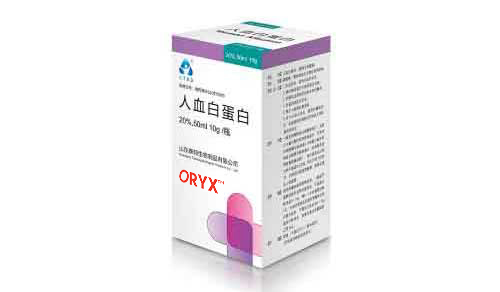Human Albumin
Common name: Human Albumin
English name: Human Albumin
Pinyin: Renxue Baidanbai
[Ingredients] Human albumin, the auxiliary material is sodium octanoate.
[Properties] Slightly viscous, yellow or green to brown clear liquid.
[Indications]
- Blood loss trauma, shock caused by burns.
- Increased intracranial pressure caused by cerebral edema and operation.
- Edema or ascites caused by cirrhosis and kidney disease.
- Prevention and treatment of hypoproteinemia.
- Neonatal hyperbilirubinemia.
- For cardiopulmonary bypass, adjuvant treatment of burns, adjuvant therapy for hemodialysis, and adult respiratory distress syndrome.

[Specification] 2g/bottle, 5g/bottle, 10g/bottle
[Dosage]
Usage: Generally use intravenous drip or intravenous bolus. In order to prevent dehydration of the body tissue during a large number of injections, 5% dextrose injection or 0.85% sodium chloride injection may be appropriately diluted for intravenous drip (a blood transfusion device equipped with a strainer device should be used). The drip rate should be no more than 2ml per minute, but within the first 15 minutes, pay special attention to the slow speed and gradually accelerate to the above speed.
Dosage: The dosage is considered by the physician at its discretion. Generally, it is caused by severe burns or blood loss. It can be directly injected into the product by 5~10g, and repeated injection once every 4~6 hours. In the treatment of chronic albumin deficiency such as kidney disease and cirrhosis, this product can be injected daily 5~10g until the swelling disappears and the serum albumin content returns to normal.
[Adverse reactions] The use of this product generally does not produce adverse reactions, occasionally chills, fever, facial flushing, rash, nausea and vomiting and other symptoms, rapid infusion can cause vascular overload caused by pulmonary edema, occasional allergic reactions.
[Taboo]
- Those who are severely allergic to albumin.
- Patients with hypertension, acute heart disease, normal blood volume and high blood volume in patients with heart failure.
- Patients with severe anemia.
- Renal dysfunction.
[Precautions]
- The liquid may appear turbid, precipitated, cracked in foreign objects or bottles, loose caps, expired failure, etc.
- After the product is opened, it should be completed once, not scored or used for the second person.
- If the patient is found to have an uncomfortable reaction during the infusion, stop using it immediately.
- Those who have obvious dehydration should replenish at the same time.
- Freezing is strictly prohibited during transportation and storage.
- The osmolality of this product is 210~400mOsmol/kg.
[Pregnant women and lactating women] The use of drugs for pregnant women or women who may be pregnant should be cautious. If necessary, use them under the guidance of doctors and close observation.
[Child medication] This experiment was not performed and there is no reliable reference.
[Geriatric Use] This experiment was not performed and there is no reliable reference.
[Drug interaction] This product should not be mixed with vasoconstrictor, proteolytic enzyme or injection containing alcohol solvent.
[Drug overdose] Because of the hyperosmotic effect of this product, excessive injection can cause dehydration, increased circulating load, congestive heart failure and pulmonary edema.
[Pharmacology and Toxicology]
- Increase blood volume and maintain plasma colloid osmotic pressure: albumin accounts for 80% of plasma colloid osmotic pressure, mainly regulating the dynamic balance of water between tissue and blood vessels. Due to the high molecular weight of albumin, the slower penetration rate through the membrane compared with salt and water, the colloid osmotic pressure of albumin and the static pressure of capillaries are balanced to maintain normal and constant blood volume; In the blood circulation, 1 g of albumin can retain 18 ml of water, and the ability of each 5 g of albumin to retain water in the circulation is equivalent to the function of 100 ml of plasma or 200 ml of whole blood, thereby increasing the circulating blood volume and maintaining the plasma colloid osmotic pressure.
- Transportation and detoxification: Albumin can bind to anions and can also bind cations. It can transport different substances, and can also transport toxic substances to detoxification organs.
- Nutritional supply: tissue protein and plasma protein can be transformed into each other. When nitrogen metabolism is disordered, albumin can be used as a nitrogen source to provide nutrition for tissues.
[Pharmacokinetics] This experiment was not performed and there is no reliable reference.
[Storage] Store at room temperature (not exceeding 30 ° C) in the dark.
[Package] butyl rubber medicinal stopper, molded antibiotic glass bottle; 1 bottle/box, 100 boxes/box.
[Validity] 36 months.
[Executive Standards] "Chinese Pharmacopoeia" 2010 edition three, YBS00362005
[Approval number] Sinopharm quasi-word S10970005 (20%: 50ml), national medicine quasi-word S10970001 (20%: 25ml), national medicine quasi-word S10970002 (20%: 10ml)
Download PDF